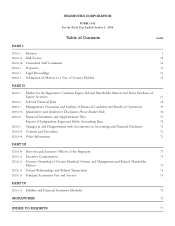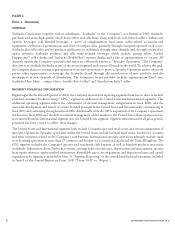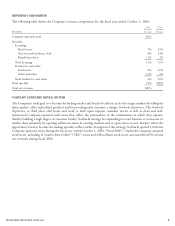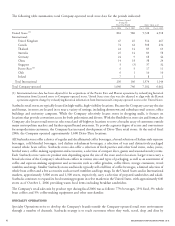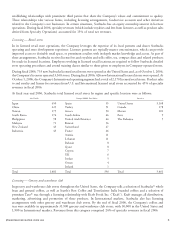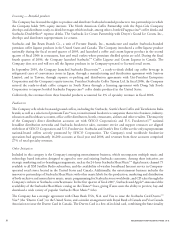Starbucks 2006 Annual Report Download - page 15
Download and view the complete annual report
Please find page 15 of the 2006 Starbucks annual report below. You can navigate through the pages in the report by either clicking on the pages listed below, or by using the keyword search tool below to find specific information within the annual report.• failing to anticipate, appropriately invest in and effectively manage the human, information technology and
logistical resources necessary to support the growth of its business, including managing the costs associated with
such resources;
• failing to integrate, leverage and generate expected rates of return on investments, including expansion of existing
businesses and expansion through domestic and foreign acquisitions;
• failing to generate sufficient future positive operating cash flows and, if necessary, secure adequate external
financing to fund its growth;
• declines in general consumer demand for specialty coffee products;
• failing to meet customer demand efficiently during peak periods;
• lack of customer acceptance of new products;
• lack of customer acceptance of Starbucks products in new markets;
• failing to consistently provide high quality products and innovate new products and business processes to retain
the Company’s existing customer base and attract new customers;
• increases in the price of high quality arabica coffee, dairy products, fuel, energy or other consumables, and the
Company’s inability to obtain a sufficient supply of such commodities and consumables as its business grows;
• failing to manage the impact of any adverse publicity regarding the Company’s business practices or the health
effects of consuming its products;
• increased labor costs, including significant increases in health care benefits and worker’s compensation insurance
costs;
• litigation against Starbucks, particularly any class action litigation;
• unfavorable general economic conditions in the markets in which Starbucks operates, including, but not limited
to, changes in interest rates, unemployment rates, disposable income and other events or factors that adversely
affect consumer spending;
• unanticipated changes in executive management;
• any material interruption in the Company’s supply chain, such as material interruption of roasted coffee supply
due to the casualty loss of any of the Company’s roasting plants, or material interruption in the supply of fluid
milk or paper and plastic products such as cups, lids, napkins, straws, shopping bags and corrugated paper boxes,
in each case due to the inability of one or more key suppliers to fulfill the Company’s requirements;
• the impact of initiatives by competitors and increased competition generally;
• failing to manage the impact on Starbucks business of factors such as labor discord, war, terrorism, political
instability in certain markets and natural disasters; and
• interruptions in service by common carriers that ship goods within the Company’s distribution channels.
• The Company’s success depends substantially on the value of the Starbucks brand.
Starbucks believes it has built an excellent reputation globally for the quality of its products, for delivery of a consistently
positive consumer experience and for its corporate social responsibility programs. The Starbucks brand has been highly
rated in several global brand value studies. Management believes it must preserve and grow the value of the Starbucks
brand to be successful in the future, particularly outside of North America, where the Starbucks brand is less well known.
Brand value is based in part on consumer perceptions as to a variety of subjective qualities, and can be damaged badly even
by isolated business incidents that degrade consumer trust, particularly if the incidents receive considerable publicity or
result in litigation. Consumer demand for the Company’s products and its brand equity could diminish significantly if
STARBUCKS CORPORATION, FORM 10-K 11


